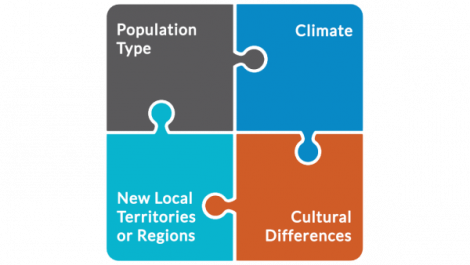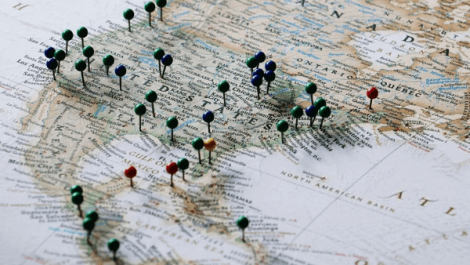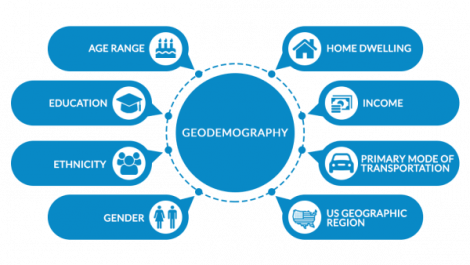What is geographic segmentation?
Pop into any convention or meeting — a group of teachers at a national conference, for example — and take a look around. Your peers will probably be wearing name tags with two pieces of information on them: their name and where they’re from. This is your first clue that geographic segmentation, wherein brands segment their target audience according to location, is one of the easiest target audience segmentations to work with.
Whether we know it or not, we base much of our identity on where we are from. In many states and countries, there’s a sense of pride in being “from there.” Stroll through any Fred Meyer grocery store in Alaska, and you’ll find dozens of hoodies and t-shirts proclaiming that its wearer is “Alaska Grown.”
In Montana, you’re bound to see bumper stickers that say “GET LOST…in Montana.” The subtext in both these cases is clear: my state, my home, is wonderful. It’s part of who I am and I want you to recognize it.
People often feel pride when it comes to where they live. Our home state or country is often one of the first pieces of information we share about ourselves. And it deeply affects which types of products we buy, and when.
What variables are used as the basis for the geographic segmentation of markets?

While audience location is a starting point for geographic segmentation, the scope of research goes beyond that. There are several geographic variables we can use for geographic segmentation (also called location segmentation).
Climate
Have you ever seen cross-country ski gear for sale in south Florida? While you could technically cross-country ski on Florida’s flat plains were they covered with snow, they’re never covered with snow. The last time snow fell to the ground in Florida? 1977, and it didn’t last long.

A winter-gear brand like Rossignol would waste its money marketing to those who live in Florida. It would do much better in states that see a large amount of snow, like Alaska, Montana, Idaho, and even parts of Arizona and New Mexico.
Conversely, swimwear manufacturers should focus their marketing efforts on locations that have lots of sunshine and water.
It’s good to know the attitudes and behaviors of customers from several climates, though. Their seasonal purchases vary in ways that might surprise you. In Alaska, swimwear goes on sale each January. Average January temperatures hover around 10 degrees Fahrenheit in Anchorage and 2 degrees in Fairbanks. Which is exactly why hordes of Alaskans ditch the state in January and February for their annual Hawaii winter vacation. The whole family needs snazzy new swimsuits for such a trip, and local stores know it.
Cultural differences
It’s fascinating to visit a Starbucks or McDonald’s in a different country. At first glance, things seem pretty familiar. But then you start reading the menu.
At Starbucks in the Chinese cities of Shanghai, Jiangsu, and Zhejiang, you can purchase oat scones with a red bean filling. In South Africa, Starbucks features
In coffee-loving Italy, where the first Starbucks made its debut in 2018, Starbucks hardly offers any of its classic drinks. Instead it “[focuses] on local market preferences such as espressos, as well as made-to-order ice cream and pizza.”
Starbucks knows exactly how to target its customers in any given location. (So does McDonald’s — at its Thailand locations, for example, you can try macaroni soup or a Samurai Pork burger.)
While many large restaurant and retail chains know how to adjust their marketing and products in any given location, smaller businesses can benefit from knowing and appreciating these differences, too. Pay attention to the culture around you and marry its preferences to your brand.
How to market to a new geographical region
If you’re bringing a product or service to new regions, it benefits you to mark your new territory. Say you’re opening an independent toy store in a new geographic location. It’s a small midwestern town, where your only competition is the local Walmart. How can you put your store on everyone’s radar?

You can post new-store specials and savings in places families tend to spend time: the grocery store, the local library, and doctor’s offices.
In addition, target your area’s residents via social media. Make a Facebook page for your business and run Facebook Ads that target potential customers in your new town and its surrounding communities.
Population type

People who live in densely populated cities will have different wants and needs than those living in rural communities. A Home Depot in New York City might focus its Garden Center offerings on products and plants that do well in a patio or porch setting. Meanwhile, a Home Depot in Iowa might instead focus on stocking up with plenty of seeds, starter plants, and other products needed for large gardens and fields. Home Depot’s target audience is also affected by factors such as the average household income of the area, the distance people are used to driving to get to a store, and the local design and decor preferences.
Whatever type of product or service your brand sells, you need to know what types of neighborhoods and residential areas surround you. How many people live there? Is your new place of business surrounded by commercial properties and workspaces that’ll give you most of your business during the weekday?
Knowing these answers helps you efficiently target your local audience.
How is geographic segmentation used in consumer markets?

Once a brand knows what product or service it will sell, it can segment its target audience in several ways. If an online brand sells both cold- and warm-weather gear, it can segment its audience according to climate, a way to personalize the brand’s campaigns. To its warm-weather buyers, the brand markets light sweaters or jackets, along with swimwear. Those buyers won’t see any ads that feature heavy coats. Ads for snow gear will go to the brand’s customer base in cold areas.
If this same brand’s reach extends to other countries, it can take a geographic segmentation sample of that community. That way, marketers will find out how to adjust the campaign or the product itself to fit cultural preferences. This process is what’s known as culture segmentation.
In essence, geographic segmentation is used to improve the customer’s buying experience by making a product relevant and beneficial to your target audience — which benefits the business.
How do you do geographic segmentation?
In order to segment your audience by geography, you need to know where they are. You might be wondering how exactly to find out a customer’s geographic location. Thankfully, this is a piece of information that many people willingly give.
If you run a brick-and-mortar business, you obviously already know that your audience is from the same area you are. Still, it’s good to research your setting to see how many more geographic variables you can discover.
To find out details about population density/type and cultural preferences, you can try a few things. You might hand out surveys to your customers, along with coupons or discounts on your products if they bring the survey back answered or complete it online.
If you’re a hardware store, the survey can ask questions about what types of plants are most beneficial to your market, and so on. If you’re a clothing boutique, ask your audience when in the year they start switching over to warmer layers — and which types of layers they prefer. This information can help you understand when to stock your shelves with products your customers will readily purchase.
If you’re an
What companies use geographic segmentation?
Just about every major retail and restaurant chain you can think of uses geographic segmentation. We looked at a few companies earlier.
Have you ever noticed that outlet malls tend to be in out-of-the-way areas? Think of the Desert Hills Outlets in the southern California desert. Tourists could easily purchase Gucci in the same city they fly into (Los Angeles). But would it be smart for Gucci to place its discount store right next to its full-price store? Of course not! So if shoppers are thinking about economics and want a deal, they have to be willing to drive out into the middle of nowhere to find them. Buyers with less time and more money will stay in the city and get their Gucci fix there. Whether luxury goods or outlet sales, Gucci demographic segmentation relies heavily on how much disposable income a person may have and how they want to spend it.
This example is a classic case of a company using geography to meet various audience needs in a way that benefits the brand. Keep reading for more examples of companies using geographic segmentation.
Have you heard of geodemographics?
So you know where your target audience lives. You’ve segmented your audience according to each geographic variable. But you feel like you need to dig a little deeper into the geographic information at hand. Or maybe it’s the demographic information. Or both.

While you can certainly carry out both geographic and demographic segmentation on your target audience, there is an established market segmentation strategy that combines them. It’s called geodemographic segmentation.
Geodemographics is when you’ve studied the data for a geographic location and then further research the demographics within it. We’ve already touched on this idea a bit with Home Depot’s target audience, but let’s look a little closer.
Geodemographic segmentation example
Say you’re a McDonald’s opening a new location in a midwestern city. At first glimpse, it seems that all the denizens in the neighborhood like bland midwestern food. But then you notice there seem to be many Southeast Asians living in the area. You dig into the city’s records and discover that the area has recently seen an uptick in migrants from Cambodia and Vietnam.
You do some reading and research on both cultures and decide to incorporate some menu items with Vietnamese and Cambodian flavors. That way, you’ll appeal not only to your meat-and-potatoes farmers but also to your Vietnamese and Cambodian neighbors.
That’s geodemographic segmentation.
What geographic segments can I target on PickFu?
On PickFu, you can target the following geographic segments:
- U.S. Geographic Region - Target Pacific residents, Southwest residents, Midwest residents, Southeast residents, Rocky Mountain residents, and Northeast residents
- U.S. State - Target Alabama residents, Arizona residents, California residents, Colorado residents, Florida residents, Georgia residents, Illinois residents, Indiana residents, Iowa residents, Kentucky residents, Maryland residents, Massachusetts residents, Michigan residents, Minnesota residents, Missouri residents, Nebraska residents, New Jersey residents, New York residents, North Carolina residents, Ohio residents, Oregon residents, Pennsylvania residents, South Carolina residents, Tennessee residents, Texas residents, Virginia residents, Washington residents, West Virginia residents, and Wisconsin residents
Frequently asked questions about geographic segmentation
Geographic segmentation is when brands segment their target audience according to location.
Say an apparel company splits its audience into two: those who live in warm climates and those who get snow. Then it tailors appropriate products and campaigns to those separate areas. That’s geographic segmentation at work.
Behavioral segmentation studies a customer’s external behavior. Psychographic segmentation seeks to study a customer’s inner world: their beliefs, values, and priorities, for example.
Geographic segmentation looks at audiences based on where they are located, such as in a major city or small town. Demographic segmentation looks at audiences based on who they are, such as their age or gender. Because demographic factors change region to region, the combining of geographic and demographic segmentation is what’s known as geodemographic segmentation.
If you’re not looking at the full picture of your target market, you could be missing opportunities for your business to grow and cater to customers’ wants and needs.
Geographical variables are the ways in which a brand can geographically divide its audience. Climate, population type/density, new territory marking, and cultural preference are four main variables.
Knowing the audience’s climate if you’re an apparel business is crucial. Similarly, understanding the surrounding culture if you’re a restaurant can make or break your success.
Global companies like McDonald’s and Starbucks use geographic segmenting across the world. You’ll see foods specially created for the cultures and people in a certain geographic area. For example, a McDonald’s in Hong Kong serves fried shrimp, while a McDonald’s in the state of Maine serves a lobster roll.
What are the other types of market segmentation?


